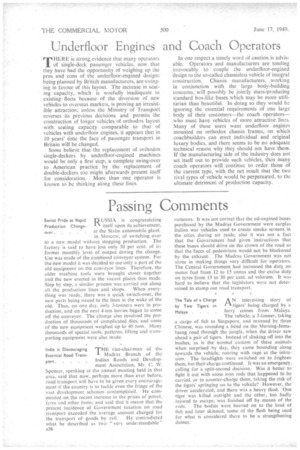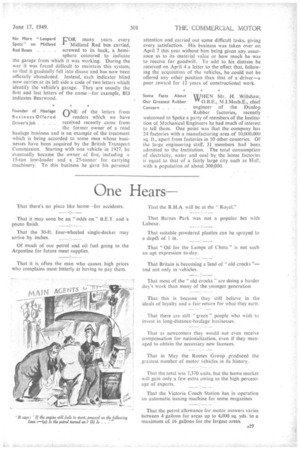Passing Comments
Page 2

Page 3

If you've noticed an error in this article please click here to report it so we can fix it.
Soviet Pride at Rapid pp USSIA is congratulating Production Change" itself upon its achievement, at the Stalin automobile plant, in Moscow, of switching over to a new model without stopping production. The factory is said to have lost only 50 per cent. of its former monthly level of output during the change. Use was made of the combined conveyor system. For the new model it was decided to use only a part of the old equipment on the conveyor lines. Therefore, the older machine tools were brought closer together and the new erected in the vacant places thus made. Step by step, a similar process was carried out along
all the production lines and shops. When everything was ready, there was a quick switch-over, the new parts being issued to the lines in the wake of the old. Thus, on one day, only 3-tonners were in production, and on the next 4-ton lorries began to come off the conveyor. The change also involved the production of thousands of complicated dies, and some of the new equipment weighed up to 40 tons. Many thousands of special tools, patterns, lifting and transporting equipment were also made.
over
India Is Discouraging THE vice-chairman of the Essential Road TransMadras Branch of the port Indian Roads and Develop
ment Association, Mr. C. W. Spencer, speaking at the annual meeting held in that area, said that now, perhaps more than ever before, road transport will have to be given every encouragement if the country is to tackle even the fringe of the vast development schemes contemplated. He commented on the recent increase in the prices of petrol, tyres and other items, and said that it meant that the present incidence of Government taxation on road transport exceeded the average amount charged for
the transport of goods by rail. He contradicted what he described as two "very understandable' A26
rumours. It was not correct that the oil-engined buses purchased by the Madras Government were surplus Italian war vehicles used to create smoke screens in the cities during air raids; also it was not a fact that the Government had given instructions that these buses should drive on the crown of the road so that the faces of.pedestrians would not be blackened by the exhaust. The Madras Government was not alone in making things very difficult for 'operators. The Central Government had increased the duty on motor fuel from 12 to 15 annas and the excise duty on tyres from 15 to 30 per cent. ad valorem. It was hard to ',believe that the legislators were not determined to stamp out road transport.
A N interesting story of 1-k tigers' being charged by a lorry comes from Malaya. The vehicle, a 3-tanner, taking a cargo of fish to Singapore, and manned by three Chinese, was rounding a bend on the Mersing-Jemaluang road through the jungle, when the driver saw ahead a pair of tigers. Instead of slinking off into the bushes, as is the normal custom of these animals when surprised by day, they came bounding along towards the vehicle, roaring with rage at the intrusion. The headlights were switched on to frighten them, but their charge continued. It was an emergency. calling for a split-second decision. Was it better to fight it out with some iron rods that happened to be carried, or to counter-charge them, taking the risk of the tigers' springing on to the vehicle? However, the driver accelerated, and there was a heavy thud. One tiger was killed outright and the other, too badly injured to escape, was finished off by means of the rods. The bodies were heaved on to the load of fish and later skinned, some of the flesh being used for what is considered there to be a strengthening dinner. The Tale of a Charge by Two Tigers in Malaya . . . . No More "Leopard g'OR many years every Spots" on Midland I Midland Red bus carried, Red Buses • . . screwed to its back, a hemi sphere coloured to indicate the garage from which it was working. During the war it was found difficult to maintain this system, so that it gradually fell into disuse and has now been officially abandoned. Instead, each indicator blind now carries at its left side a code of two letters which identify the vehicle's garage. They are usually the first and last letters of the name—for example, BD indicates Bearwood.
Founder of Haulage ('NE of the letters from Business Offered ‘--1 readers which we have Driver's fob „ received recently came from
the former owner of a road haulage business and is an example of the treatment which is being accorded to some men whose businesses have been acquired by the British Transport Commission. Starting with one vehicle in 1927, he eventually became the owner of five, including a 15-ton low-loader and a 25-tanner for carrying machinery. To this business he gave his personal attention and carried out some difficult tasks, giving every satisfaction. His business was taken over on April 7 this year without him being given any assurance as to its material value or how much he was to receive for goodwill. To add to his distress he received on April 4 a letter to the effect that, following the acquisition of the vehicles, he could not be offered any other position than that of a driver—a poor reward for 12 years of constructional work.
Some Facts About WHEN Mr. H. Willshaw,
Our Greatest Rubber Concern
O.B.E., M.I.Mech.E.,.chief engineer of the Dunlop
Rubber factories, recently welcomed to Speke a party of members of the Institution of Mechanical Engineers he had much of interest to tell them. One point was that the company has 24 factories with a manufacturing area of 10,000,000 sq. ft., apart from factories in 10 other countries. Of the large engineering staff, 31 members had •been admitted to the Institution. The total consumption of electricity, water and coal-by the home factories is equal to that of a fairly large city such as Hull, with a population of about 300,000.


























